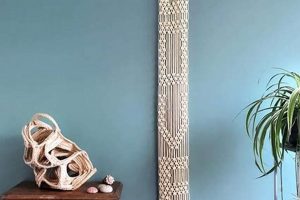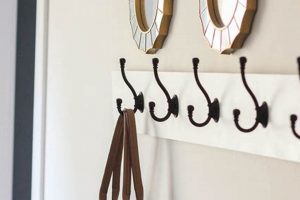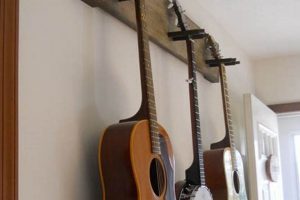The construction of simulated brick surfaces through do-it-yourself methods represents an accessible approach to interior design and renovation. This technique involves using various materials and processes to replicate the aesthetic of genuine brickwork on existing walls. An example includes applying a thin layer of joint compound to a wall and then imprinting a brick pattern before it dries.
This practice offers several advantages, including cost-effectiveness, ease of installation compared to real brick, and the potential to significantly alter a room’s appearance. Historically, faux finishes have been employed to achieve desired aesthetics without the expense or structural changes associated with authentic materials, making simulated brick a continuation of this tradition. The appeal lies in its ability to add texture, warmth, and character to a space, emulating the look of exposed brick often found in older buildings and loft-style apartments.
The following sections will delve into different methods for creating this effect, material choices, application techniques, and considerations for achieving a realistic and durable finish. Specific instructions and tips will be provided for each method, allowing individuals to effectively implement this design feature in their homes or businesses.
Application Techniques and Considerations
Achieving a convincing simulated brick effect requires careful planning and execution. Attention to detail during each step of the process is crucial for a professional-looking result.
Tip 1: Surface Preparation: Before commencing any application, ensure the wall surface is clean, dry, and free of loose debris. Priming the wall is recommended to promote adhesion and longevity of the finish. Minor imperfections should be addressed with patching compound.
Tip 2: Material Selection: The choice of materials, be it brick panels, joint compound, or paint, significantly impacts the final aesthetic. Select high-quality materials appropriate for the chosen technique. Consider factors like texture, color, and durability in relation to the intended environment.
Tip 3: Pattern Consistency: Maintaining a consistent brick pattern is vital for realism. Utilize templates, guides, or measuring tools to ensure uniform brick size and spacing. Slight variations can enhance the handmade feel, but excessive inconsistency detracts from the overall effect.
Tip 4: Mortar Detailing: The “mortar” lines are a key element. Use appropriate tools like grout bags or putty knives to create realistic mortar joints. Experiment with different application techniques to achieve desired texture and depth. Allow sufficient drying time before proceeding to subsequent steps.
Tip 5: Color Variation: Genuine brickwork often exhibits subtle color variations. Incorporate multiple shades of paint or stain to mimic this natural effect. Use layering techniques and dry brushing to add depth and dimension to individual bricks.
Tip 6: Sealing and Protection: To enhance durability and ease of cleaning, consider applying a sealant to the finished surface. Choose a sealant appropriate for the material used and the intended level of exposure to moisture or wear. Test the sealant in an inconspicuous area first.
Tip 7: Consider the Lighting: Lighting conditions affect the appearance of the faux brick. Evaluate how natural and artificial light interact with the surface and adjust color and texture accordingly. Strategic lighting can accentuate the three-dimensional effect.
Consistent application of these techniques, with careful attention to material selection and detailing, allows for the creation of a convincing and aesthetically pleasing simulated brick feature. This approach enhances the visual appeal of any space while remaining a manageable project.
The subsequent section will address common challenges encountered during the process and provide troubleshooting advice to ensure a successful outcome.
1. Material Selection
Material selection is a critical determinant in the success of any faux brick wall project. The chosen materials directly influence the final aesthetic, durability, and ease of installation. Therefore, careful consideration must be given to various options before commencing the build.
- Thin Brick Veneer
Thin brick veneer offers the most authentic appearance due to its composition from real brick. It provides a tactile and visual similarity to conventional brickwork but requires more effort to install, involving mortar application and precise cutting. It is suitable for achieving a high-end, realistic effect.
- Brick Panels
Brick panels, constructed from materials like high-density foam or plastic, offer a lightweight and straightforward installation process. These panels often feature a repeating brick pattern molded onto their surface. While they provide a quicker solution, the repeating pattern may compromise the authenticity compared to individual brick alternatives.
- Faux Brick Paint Techniques
Paint and texturing techniques offer the most economical option. This involves using stencils, sponges, or textured rollers to create the illusion of brick on an existing wall surface. While cost-effective, the aesthetic result is dependent on the skill of the applicator and the chosen texture mediums, and it may lack the three-dimensional depth of other methods.
- Joint Compound/Drywall Mud
Applying joint compound or drywall mud allows for sculpting individual “bricks” onto the wall. This method provides a customizable texture and brick size. It requires patience and artistic skill to achieve a convincing result, and the durability is lower than brick veneer or panels, demanding a protective sealant.
The choice among these materials should align with the desired level of realism, budget constraints, and the installer’s skill set. A deliberate and informed approach to material selection is essential for creating a satisfying faux brick wall that complements the intended design.
2. Surface Preparation
Adequate surface preparation is a non-negotiable precursor to any successful implementation of a simulated brick wall. It establishes the foundation upon which the aesthetic integrity and long-term adhesion of the applied materials rest. Without proper preparation, even the most meticulously executed faux brick technique will be undermined by premature failure or a compromised visual outcome. This principle applies regardless of the chosen method, be it thin brick veneer, paneling, or painted simulations. For example, applying faux brick paneling to a wall with loose wallpaper will inevitably lead to detachment of the paneling as the underlying wallpaper fails, rendering the entire endeavor futile.
The specific actions required during surface preparation depend on the existing wall condition and the chosen application method. Generally, this involves cleaning the surface to remove dust, grease, and other contaminants that could impede adhesion. Repairing imperfections such as cracks or holes with patching compound ensures a smooth and uniform substrate. Priming the surface is often recommended to enhance adhesion and prevent the underlying wall color from affecting the final appearance of the simulated brick. For instance, a dark-colored wall might require a tinted primer to ensure the desired brick color is accurately achieved, especially when using thinner paint applications. Ignoring these preliminary steps creates conditions that can lead to peeling, cracking, or an uneven finish, thus diminishing the realistic impression of the simulated brickwork.
In summary, the connection between surface preparation and a successfully executed faux brick wall is direct and undeniable. Proper surface preparation is not merely a preliminary step; it is an integral component of the entire process. Neglecting this stage creates a high probability of aesthetic shortcomings and structural failures, resulting in wasted effort and resources. Attention to detail during surface preparation establishes the necessary groundwork for a durable and visually compelling simulated brick installation.
3. Pattern Creation
The simulation of brickwork relies heavily on the accurate and consistent replication of a brick pattern. This is a pivotal element in achieving a realistic and visually convincing final product. The success of any “fake brick wall diy” project is directly correlated to the attention and precision afforded to this stage.
- Stenciling Techniques
Stenciling involves the use of pre-cut templates to transfer a brick pattern onto the prepared surface. This method provides a uniform and repeatable design, suitable for large areas. Example: A plastic stencil with a standard brick size is repeatedly aligned and painted to create a consistent pattern. Stenciling ensures uniformity but may lack the slight variations found in genuine brick, potentially reducing the overall realism.
- Taping Methods
The application of tape to delineate individual bricks allows for precise definition of the brick outlines. This technique allows customization of brick dimensions and arrangements. Example: Masking tape is applied in a staggered formation to mimic brick courses, and the spaces between the tape are then painted to create mortar lines. While providing flexibility, taping requires meticulous measurement and application to prevent inconsistencies in brick spacing and alignment.
- Freehand Sculpting
Freehand sculpting entails manually creating the brick pattern using tools and materials such as joint compound or textured rollers. This approach offers the greatest degree of customization and allows for the incorporation of subtle variations to enhance realism. Example: Joint compound is applied to the wall, and individual bricks are shaped using a trowel or similar tool. This requires significant artistic skill and precision, and it may be challenging to maintain uniformity across the entire surface.
- Panel Alignment and Seam Treatment
When using prefabricated brick panels, the proper alignment of panels and treatment of seams is crucial for a seamless appearance. Misaligned panels or poorly concealed seams detract from the overall illusion of genuine brick. Example: Brick panels are meticulously aligned, and the seams are filled with color-matched caulk or joint compound, which is then textured to blend with the surrounding brick pattern. Successful seam treatment minimizes the visibility of panel junctions, creating a more convincing continuous brick surface.
The selection of an appropriate pattern creation technique should be guided by the desired aesthetic, budget constraints, and the installer’s skill level. Each method presents unique advantages and disadvantages in terms of realism, ease of implementation, and the degree of customization possible. A well-executed pattern significantly enhances the credibility of the artificial brick effect, contributing to a visually appealing and convincing “fake brick wall diy” project.
4. Color Application
The application of color is paramount in achieving a realistic and convincing artificial brick wall. The accuracy of the color palette and the techniques employed directly influence the perceived authenticity of the finished product. Deviations from natural brick tones or improper application methods can undermine the entire effect, regardless of the quality of other construction steps. For instance, applying a single, flat color across the entire simulated brick surface results in an artificial and two-dimensional appearance, devoid of the subtle variations inherent in real brickwork. Conversely, a meticulous layering of colors, mimicking the effects of weathering and natural mineral deposits, can create a remarkably realistic impression.
The selection of appropriate coloring agents is crucial. Pigments should be durable, resistant to fading, and compatible with the underlying materials used to create the simulated brick texture. A common practice involves using a base coat in a reddish-brown hue, followed by washes of diluted paint in terracotta, ochre, and umber tones. Dry brushing techniques can then be employed to highlight edges and add subtle variations in shade. Mortar lines typically require a contrasting color, often achieved with a light gray or off-white paint applied with precision to avoid smudging onto the brick surfaces. In situations where a whitewashed or distressed brick effect is desired, a diluted white paint is applied and then partially removed to reveal the underlying colors and textures, simulating years of accumulated weathering.
In summary, strategic color application is not merely a cosmetic step but a fundamental element in creating a credible and visually compelling artificial brick wall. A nuanced understanding of color theory, combined with skillful application techniques, is essential for transforming a basic construction into a convincing replica of genuine brickwork. This process presents challenges, including color matching and achieving consistent results across large surfaces, but the final visual impact justifies the attention and effort invested in this crucial phase.
5. Mortar Detailing
Mortar detailing represents a critical component in the creation of convincing artificial brick walls. It is the element that defines the visual separation between individual bricks and contributes significantly to the overall realism of the simulated structure. The texture, color, and consistency of the simulated mortar joints are all crucial factors in replicating the aesthetic of genuine brickwork.
- Mortar Joint Width and Depth
The dimensions of mortar joints are vital in mimicking authentic brick construction. Mortar joints that are too wide or too shallow will detract from the realism. A typical mortar joint width ranges from 3/8 inch to 1/2 inch, with a slight recess to create shadow lines. For example, consistently applying a 3/8 inch joint between faux bricks ensures a visually balanced and structurally sound appearance.
- Mortar Color Selection
Mortar color significantly influences the overall aesthetic of a simulated brick wall. While gray is a common choice, variations in shade, ranging from light gray to dark charcoal, can dramatically alter the visual impact. Selecting a mortar color that complements the brick color and the intended design style is essential. Using a white or light gray mortar can brighten the wall, while a darker mortar can emphasize the individual bricks.
- Mortar Texture and Application Techniques
The texture of the mortar joints contributes to the tactile and visual authenticity of the artificial brick wall. Different application techniques can produce varied textures, from smooth and uniform to rough and aged. Applying mortar with a grout bag and then tooling it with a jointing tool can create a professional, consistent finish. Conversely, using a sponge or brush to apply mortar can produce a more rustic, irregular texture.
- Mortar Joint Consistency and Uniformity
Maintaining consistency in the application of mortar is key to achieving a realistic brick effect. Variations in mortar thickness or application can create an uneven and artificial appearance. Ensuring uniform depth and width of the mortar joints, especially across large surfaces, requires meticulous attention to detail. The use of spacers or guides can aid in maintaining consistent mortar joint dimensions.
These facets of mortar detailing underscore its importance in the overall success of artificial brick wall projects. Meticulous attention to width, color, texture, and consistency ensures a realistic and visually compelling outcome. In contrast, neglecting any of these aspects diminishes the credibility of the simulation, resulting in an artificial and unconvincing aesthetic.
6. Sealing Application
The application of a sealant to a constructed simulated brick wall is a critical final step that directly influences the longevity, maintainability, and overall aesthetic integrity of the project. This process provides a protective barrier against moisture penetration, staining, and abrasion, thereby preserving the visual appeal and structural integrity of the faux brick surface. The absence of a sealant can lead to accelerated deterioration, particularly in environments with high humidity or exposure to spills and physical contact. For example, a faux brick backsplash in a kitchen, unsealed, is highly susceptible to grease stains and water damage from routine cleaning, resulting in discoloration and degradation of the simulated brick material. The application of a sealant, therefore, serves as a proactive measure to mitigate these risks.
The selection of the appropriate sealant is contingent upon the materials used in the creation of the artificial brick wall. Water-based acrylic sealants are generally suitable for interior applications, offering ease of application and low odor. However, for exterior applications or areas subject to frequent moisture exposure, solvent-based polyurethane sealants provide superior durability and water resistance. The application method also impacts the effectiveness of the sealant; multiple thin coats are preferable to a single thick coat to ensure uniform coverage and prevent pooling or streaking. Furthermore, the compatibility of the sealant with the underlying paint or faux brick material should be verified to avoid adverse reactions such as discoloration or peeling. A small test area is advisable prior to full application.
In summary, the application of a sealant is an indispensable component of “fake brick wall diy,” extending beyond mere aesthetics to ensure the long-term performance and preservation of the finished product. The appropriate selection and application of a sealant mitigate the risks associated with moisture, stains, and physical wear, safeguarding the visual integrity and structural soundness of the simulated brick surface. This protective measure is a necessary investment to realize the full potential and lasting value of a faux brick wall project, preventing premature deterioration and maintaining its intended aesthetic appeal.
7. Lighting Considerations
Illumination plays a pivotal role in the perceived realism and aesthetic impact of simulated brick walls. The interplay of light and shadow accentuates texture, defines the brick pattern, and influences the overall color perception. Inadequate or poorly positioned lighting can flatten the appearance of the faux brick, diminishing the depth and dimensionality crucial to achieving a convincing illusion. Conversely, strategic lighting choices can enhance the three-dimensional effect, highlight subtle color variations, and contribute to the authenticity of the simulated brickwork. For instance, employing a grazing light source, positioned at a shallow angle to the wall, casts elongated shadows that emphasize the texture of the mortar joints and brick surfaces, thereby creating a more pronounced sense of depth.
The selection of light source characteristics, including color temperature and intensity, is also critical. Warm-toned light (around 2700K) tends to accentuate the reddish hues often associated with brick, creating a cozy and inviting atmosphere. Cooler light (around 4000K) can provide a more neutral representation of the brick color, which may be preferable in certain design contexts. Furthermore, the intensity of the light should be carefully calibrated to avoid washing out the subtle color variations in the faux brick. Dimmable lighting systems offer the flexibility to adjust the illumination levels to suit different ambient conditions and desired aesthetic effects. The strategic placement of recessed lighting, spotlights, or wall sconces can further enhance the visual impact of the simulated brick, directing light to highlight specific areas or features.
In summary, effective lighting is not merely an ancillary aspect of “fake brick wall diy,” but an integral component that significantly influences the final outcome. The deliberate consideration of light source characteristics, positioning, and intensity allows for the creation of a visually compelling and authentic simulated brick surface. Ignoring these lighting considerations diminishes the realism and potential aesthetic impact of the project, while a thoughtful and strategic approach elevates the faux brick wall from a simple imitation to a convincing and aesthetically pleasing design feature. The interplay of light and shadow is the key to unlock an authentic-looking simulated brick wall.
Frequently Asked Questions
The following questions address common inquiries and misconceptions regarding the creation and maintenance of artificial brick walls.
Question 1: What is the anticipated lifespan of a faux brick wall constructed using DIY methods?
The lifespan of a simulated brick wall depends heavily on material selection, installation technique, and environmental factors. A professionally installed thin brick veneer may last for decades, while a painted simulation may require more frequent touch-ups. Proper sealing and protection from moisture extend the longevity of any method.
Question 2: Are there specific building codes or regulations applicable to the installation of simulated brick walls?
Building codes generally do not differentiate between real and artificial brick walls for aesthetic purposes. However, fire resistance and structural considerations may apply, particularly in commercial settings. Local regulations should be consulted to ensure compliance with safety standards.
Question 3: What are the primary advantages of choosing simulated brick over genuine brick construction?
Simulated brick offers several advantages including reduced cost, ease of installation, and lower weight compared to genuine brick. It avoids the need for structural modifications and provides greater design flexibility. Simulated brick is generally simpler to install and requires minimal specialized skills.
Question 4: How can the appearance of a simulated brick wall be enhanced to more closely resemble genuine brickwork?
Achieving a realistic appearance involves careful attention to detail in pattern creation, color application, and mortar detailing. Employing multiple shades of paint, creating irregular brick patterns, and using textured mortar enhance the visual authenticity.
Question 5: What are the recommended cleaning procedures for maintaining the appearance of a simulated brick wall?
Cleaning procedures depend on the materials used and the sealant applied. Generally, gentle cleaning with a mild detergent and a soft cloth is recommended. Abrasive cleaners should be avoided as they can damage the surface or sealant. Regular dusting prevents the buildup of dirt and grime.
Question 6: Can simulated brick walls be effectively installed in high-moisture environments such as bathrooms or basements?
Yes, simulated brick walls can be installed in high-moisture environments, provided that appropriate moisture-resistant materials and sealants are used. Proper ventilation and regular maintenance are also essential to prevent mold growth and water damage.
These answers offer a concise overview of crucial considerations related to simulated brick wall projects, enabling informed decision-making and successful implementation.
The following section will explore specific case studies and examples of successful simulated brick wall installations.
Conclusion
The preceding exploration of “fake brick wall diy” detailed the multifaceted aspects of this construction method, ranging from material selection and surface preparation to pattern creation, color application, mortar detailing, sealing, and lighting considerations. Each step presents critical junctures that influence the realism, durability, and aesthetic appeal of the finished simulated brick surface. The integration of these elements determines the overall success of the project, enabling the creation of a cost-effective and visually compelling alternative to genuine brickwork. The significance of meticulous planning and execution cannot be overstated, as deviations from established best practices will compromise the intended outcome.
The implementation of “fake brick wall diy” represents a viable option for homeowners and businesses seeking to replicate the aesthetic of exposed brick without incurring the expenses and structural alterations associated with traditional brick construction. Continued innovation in materials and techniques promises to further enhance the realism and accessibility of this approach. The successful application of these techniques requires diligence, patience, and a commitment to detail, enabling the transformation of ordinary spaces into visually appealing and aesthetically engaging environments. Through the integration of these methods, the potential for achieving a durable and visually impressive simulated brick finish becomes an attainable objective.







